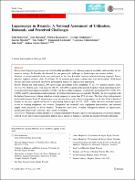| dc.contributor.author | Robertson, Faith | |
| dc.contributor.author | Mutabazi, Zeta | |
| dc.contributor.author | Kyamanywa, Patrick | |
| dc.contributor.author | Ntakiyiruta, Georges | |
| dc.contributor.author | Musafiri, Sanctus | |
| dc.contributor.author | Walker, Tim | |
| dc.contributor.author | Kayibanda, Emmanuel | |
| dc.contributor.author | Mukabatsinda, Constance | |
| dc.contributor.author | Scott, John | |
| dc.contributor.author | Costas-Chavarri, Ainhoa | |
| dc.date.accessioned | 2022-04-26T17:05:26Z | |
| dc.date.available | 2022-04-26T17:05:26Z | |
| dc.date.issued | 2019 | |
| dc.identifier.citation | Robertson, F., Mutabazi, Z., Kyamanywa, P., Ntakiyiruta, G., Musafiri, S., Walker, T., Kayibanda, E., Mukabatsinda, C., Scott, J. and Costas-Chavarri, A. (2019). Laparoscopy in Rwanda: a national assessment of utilization, demands, and perceived challenges. World Journal of Surgery, 43(2), pp.339-345. | en_US |
| dc.identifier.issn | 0364-2313 / 1432-2323 | |
| dc.identifier.uri | http://hdl.handle.net/20.500.12280/2967 | |
| dc.description.abstract | Background: Laparoscopy has proven to be feasible and effective at reducing surgical morbidity and mortality in low resource settings. In Rwanda, the demand for and perceived challenges to laparoscopy use remain unclear.
Methods: A mixed-methods study was performed at the four Rwandan national referral teaching hospitals. Retrospective logbook reviews (July 2014-June 2015) assessed procedure volume and staff involvement. Web-based surveys and semi-structured interviews investigated barriers to laparoscopy expansion.
Results: During the study period, 209 laparoscopic procedures were completed: 57 (27.3%) general surgery cases; 152 (72.7%) ob/gyn cases. The majority (58.9%, 125/209) occurred at the private hospital, which performed 82.6% of cholecystectomies laparoscopically (38/46). The three public hospitals, respectively, performed 25% (7/28), 15% (12/80), and 0% (denominator indeterminate) of cholecystectomies laparoscopically. Notably, the two hospitals with the highest laparoscopy volume relied on a single surgeon for more than 85% of cases. The four ob/gyn departments performed between 4 and 87 laparoscopic cases (mostly diagnostic). Survey respondents at all sites listed a dearth of trainers as the most significant barrier to performing laparoscopy (65.7%; 23/35). Other obstacles included limited access to training equipment and courses. Equipment and material costs, equipment functionality, and material supply were perceived as lesser barriers. Twenty-two interviews revealed widespread interest in laparoscopy, insufficient laparoscopy exposure, and a need for trainers.
Conclusion: While many studies identify cost as the most prohibitive barrier to laparoscopy utilization in low resource settings, logbook review and workforce perception indicate that a paucity of trainers is currently the greatest obstacle in Rwanda. | en_US |
| dc.language.iso | en | en_US |
| dc.publisher | Springer , One New York Plaza, Suite 4600 , New York, United States, Ny, 10004 | en_US |
| dc.relation.ispartofseries | World Journal of Surgery;43(2) | |
| dc.subject | Laparoscopy | en_US |
| dc.subject | Assessment | en_US |
| dc.subject | Utilization | en_US |
| dc.subject | Demands | en_US |
| dc.subject | Rwanda | en_US |
| dc.title | Laparoscopy in Rwanda: A National Assessment of Utilization, Demands, and Perceived Challenges | en_US |
| dc.type | Article | en_US |


